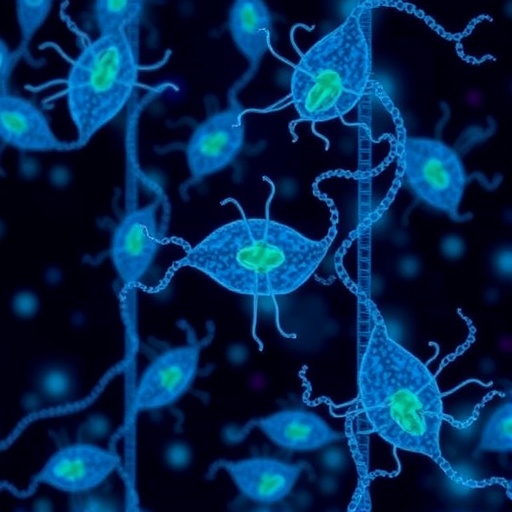In a groundbreaking development that could reshape the landscape of parasitic disease treatment, recent research has uncovered the potent anti-parasitic properties of perillyl alcohol against Toxoplasma gondii, the causative agent of toxoplasmosis. This discovery offers fresh hope for combating a widespread and often insidious infection affecting a significant portion of the global population. By specifically targeting the parasite’s genetic pathways involved in isoprenylation—a critical post-translational modification—perillyl alcohol has demonstrated remarkable efficacy in disrupting parasite survival, opening new doors for therapeutic innovation.
Toxoplasma gondii is a protozoan parasite capable of infecting essentially all warm-blooded animals, including humans. Infection typically occurs via ingestion of contaminated food or water, or exposure to cat feces. While generally asymptomatic in healthy individuals, toxoplasmosis can cause severe complications in immunocompromised patients and congenitally infected fetuses, including encephalitis, ocular damage, and fetal developmental abnormalities. Existing treatments are limited by toxicity, side effects, and incomplete parasite eradication, underscoring the urgent need for novel, targeted interventions.
Perillyl alcohol, a naturally occurring monoterpene found in the essential oils of various plants such as lavender, has previously been studied for its anticancer and antimicrobial effects. However, its potential as an anti-parasitic agent against T. gondii marks an exciting advancement. The study by Yu, Song, Li, and colleagues rigorously elucidates how perillyl alcohol disrupts the parasite’s biochemical machinery by modulating the expression of genes pivotal for isoprenylation—a lipid modification essential for proper protein function and cellular viability within T. gondii.
Isoprenylation involves the attachment of isoprenoid groups to target proteins, influencing their membrane localization, protein-protein interactions, and overall activity. In parasites like T. gondii, this process is indispensable for their intracellular lifecycle, enabling survival, replication, and evasion of the host immune system. By interfering with this modification, perillyl alcohol effectively sabotages fundamental parasite processes, rendering it incapable of maintaining the infection.
The researchers employed sophisticated molecular biology techniques to analyze gene expression profiles following treatment with perillyl alcohol. Their data revealed a downregulation of genes encoding enzymes critical for the isoprenylation pathway, including farnesyltransferase and geranylgeranyltransferase components. These enzymes facilitate the enzymatic attachment of isoprenoid units to cysteine residues on substrate proteins, a modification without which the target proteins fail to reach their functional destinations, leading to impaired parasite physiology.
Complementing these genetic analyses, the study utilized in vitro cultures of T. gondii to observe the functional impacts of perillyl alcohol treatment. The compound demonstrated a dose-dependent inhibition of parasite replication and invasion capabilities. Importantly, the selective targeting of parasite-specific isoprenylation machinery suggests a favorable therapeutic index, minimizing host cell toxicity—a critical consideration for drug development.
The implications of these findings extend beyond toxoplasmosis. Isoprenylation is a conserved biochemical process across various pathogenic organisms, including other protozoan parasites such as Plasmodium species responsible for malaria. The realization that perillyl alcohol can modulate this pathway suggests a unified strategy for targeting multiple parasitic infections through a shared vulnerability, heralding a new era of broad-spectrum antiparasitic agents derived from natural products.
Furthermore, this research highlights the burgeoning potential of repurposing phytochemicals traditionally valued for their aromatic and therapeutic properties into potent antiparasitic compounds. The natural origin and previously documented safety profile of perillyl alcohol accelerate its prospects for clinical translation, as pharmacokinetic and toxicological data are increasingly available to support further development.
Given the global health burden posed by toxoplasmosis—especially in regions with limited healthcare infrastructure—therapeutic agents like perillyl alcohol could revolutionize treatment paradigms. This compound’s ability to disrupt parasite-specific pathways while sparing host cells aligns perfectly with the precision medicine approach, promising improved outcomes with reduced adverse effects.
Further investigations are underway to elucidate the full scope of perillyl alcohol’s molecular interactions within the parasite. Understanding how this compound interfaces with the broader metabolic networks of T. gondii will inform the optimization of dosage, delivery methods, and potential synergistic combinations with existing antiparasitic drugs.
Moreover, the team explores the pharmacodynamics and pharmacokinetics of perillyl alcohol in relevant animal models. These studies are paramount to establishing the compound’s efficacy and safety profiles in vivo, paving the way for clinical trials targeting human toxoplasmosis.
Intriguingly, the study also sparks renewed interest in the role of isoprenylation as a drug target in parasitology. Previous efforts to inhibit prenyltransferases have been hampered by issues of specificity and toxicity; however, natural compounds like perillyl alcohol offer unique structural frameworks that can be further refined through medicinal chemistry approaches.
The anti-parasitic spectrum of perillyl alcohol could also offer insights into combination therapies that tackle drug resistance—an emerging problem with current antiparasitic drugs. Targeting essential post-translational modifications represents a novel mechanism distinct from classical antimicrobial actions, potentially reducing the rate at which resistance develops.
In light of these promising data, the global biomedical community eagerly anticipates the translation of these findings from bench to bedside. The integration of molecular parasitology, natural product chemistry, and pharmacology encapsulated in this study sets a precedent for innovative, multidisciplinary approaches to infectious disease management.
To summarize, the research by Yu and colleagues unveils perillyl alcohol as a formidable natural agent against Toxoplasma gondii, operating through a sophisticated mechanism of gene expression modulation within the parasite’s isoprenylation pathway. This discovery not only enhances our understanding of parasite biology but also kindles hope for new, effective therapies against toxoplasmosis and potentially other parasitic diseases.
Subject of Research: Anti-parasitic effect of perillyl alcohol on Toxoplasma gondii via regulation of genes involved in isoprenylation.
Article Title: Perillyl Alcohol Exerts an Anti-Toxoplasma gondii Effect by Regulating the Expression of Genes Related To Isoprenylation.
Article References:
Yu, Y., Song, Q., Li, H. et al. Perillyl Alcohol Exerts an Anti-Toxoplasma gondii Effect by Regulating the Expression of Genes Related To Isoprenylation. Acta Parasit. 70, 130 (2025). https://doi.org/10.1007/s11686-025-01063-6
Image Credits: AI Generated




